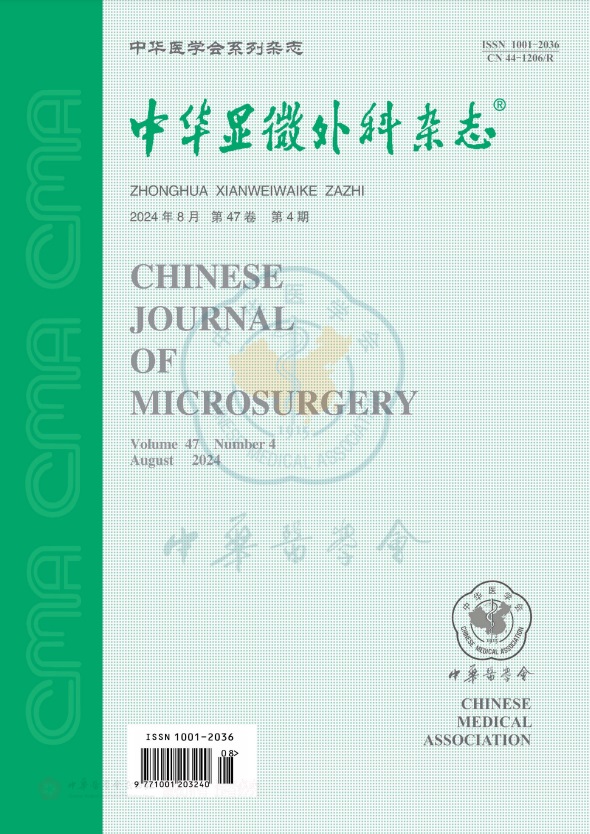KISS股前外侧皮瓣修复多指背侧软组织缺损的应用
引用次数: 0
摘要
目的评价游离KISS股前外侧皮瓣修复指背侧软组织缺损的手术方法及临床效果。方法自2014年1月至2019年6月,对7例多指背侧软组织缺损患者进行治疗。第一步,使用KISS股前外侧皮瓣,通过缝合指掌皮肤在相邻受影响手指之间形成临时并指。供体部位直接缝合。第二步,1-3个月后进行了部分去膨和并指分裂手术。对所有病例进行随访,观察皮瓣的外观、质地、功能和供区。结果皮瓣全部成活,均出现无血液循环障碍。随访时间3~24个月,平均12.5个月。皮瓣外观、质地和颜色都很好。重建手指的背侧在皮瓣松脱和并指分裂后表现出美观的效果。供体部位只留下一道线状疤痕,大腿没有功能缺损。结论游离KISS股前外侧皮瓣修复多指背侧皮肤缺损,可简化手术,缩短手术时间,减少手术创伤。关键词:大腿前外侧皮瓣;手指;KISS皮瓣;修理;显微外科手术本文章由计算机程序翻译,如有差异,请以英文原文为准。
Application of KISS anterolateral thigh flap in repairing soft tissue defect of dorsal side of multiple fingers
Objective
To evaluate the surgical technique and clinical effect of free KISS anterolateral thigh flap in repairing soft tissue defect of dorsal side of fingers.
Methods
From January, 2014 to June, 2019, 7 patients with soft tissue defects in dorsal side of multiple fingers were treated. Step one, a KISS anterolateral thigh flap was used and a temporary syndactyly between adjacent affected fingers was created by suture of the digital palmar skin. The donor sites were sutured directly. Step two, a procedure of partial de-bulking and division of syndactyly was followed-up 1-3 months later. All cases were followed-up in observations of appearance, texture, functions and donor site of flaps.
Results
All flaps survived, and all went through disorders of no blood circulation. The followed-up time were 3 to 24 (average 12.5) months. The flaps had fine appearance, texture and colour. The dorsal aspects of reconstructed fingers demonstrated an aesthetically pleasing effect after the flap de-bulking and division of syndactyly. The donor site only left a linear scar, and the thigh had no functional deficit.
Conclusion
Free KISS anterolateral thigh flap in repairing defects of dorsal skin in multiple fingers could simplify the operation, shorten operative time and reduce surgical trauma.
Key words:
Anterolateral thigh flap; Finger; KISS flap; Repair; Microsurgical operation
求助全文
通过发布文献求助,成功后即可免费获取论文全文。
去求助
来源期刊
CiteScore
0.50
自引率
0.00%
发文量
6448
期刊介绍:
Chinese Journal of Microsurgery was established in 1978, the predecessor of which is Microsurgery. Chinese Journal of Microsurgery is now indexed by WPRIM, CNKI, Wanfang Data, CSCD, etc. The impact factor of the journal is 1.731 in 2017, ranking the third among all journal of comprehensive surgery.
The journal covers clinical and basic studies in field of microsurgery. Articles with clinical interest and implications will be given preference.

 求助内容:
求助内容: 应助结果提醒方式:
应助结果提醒方式:


